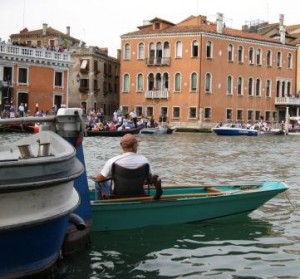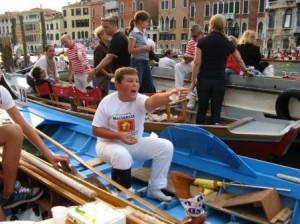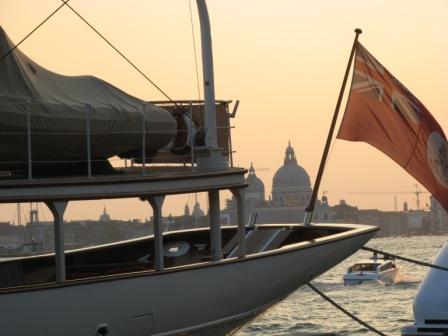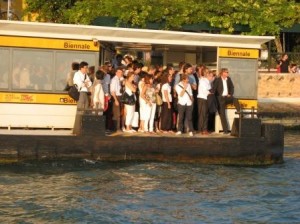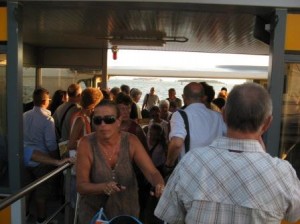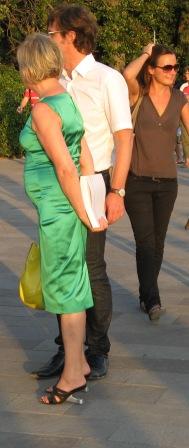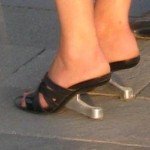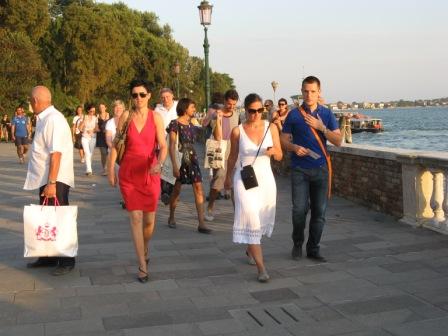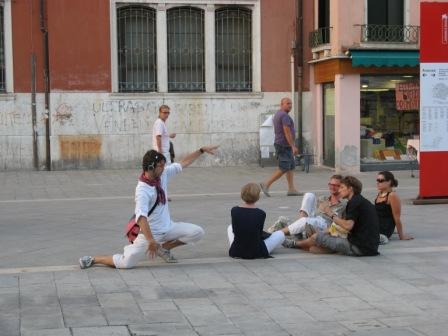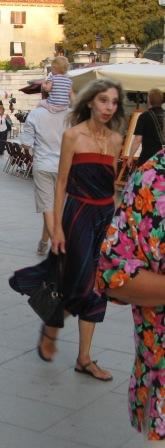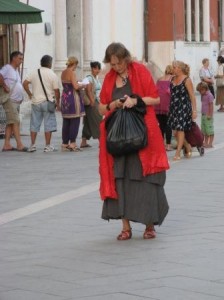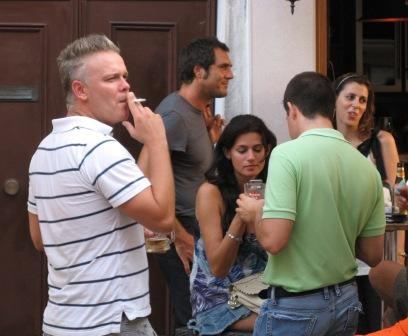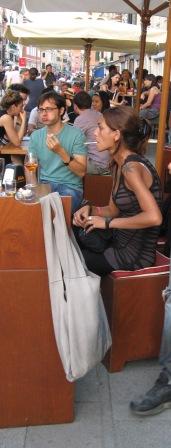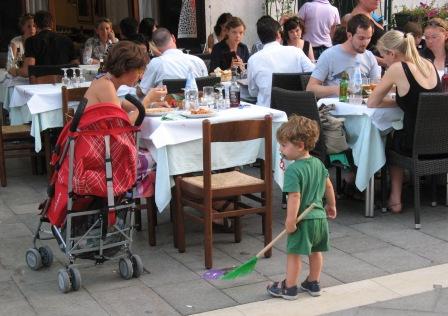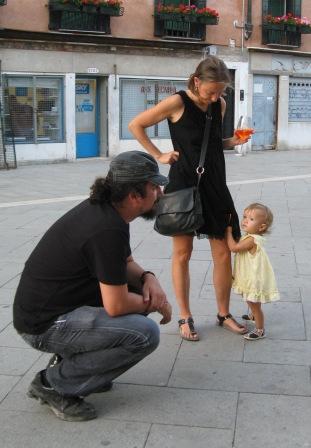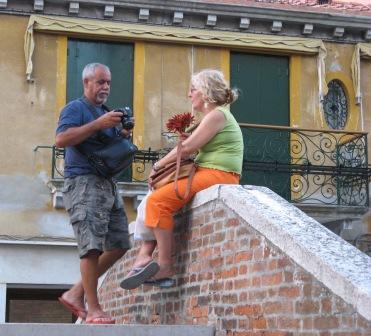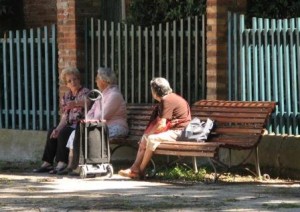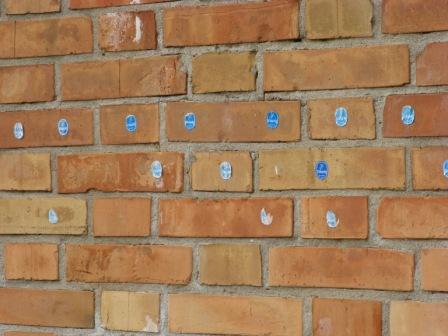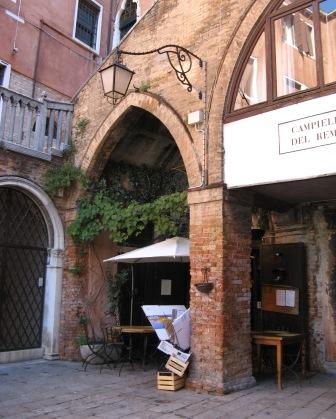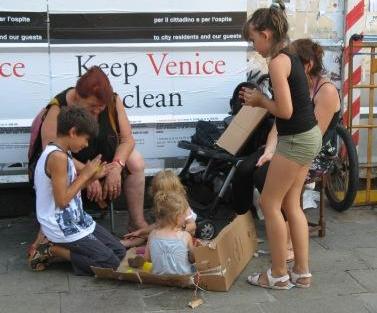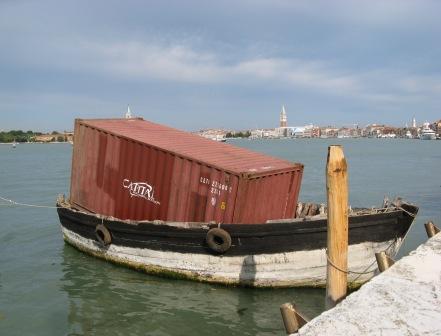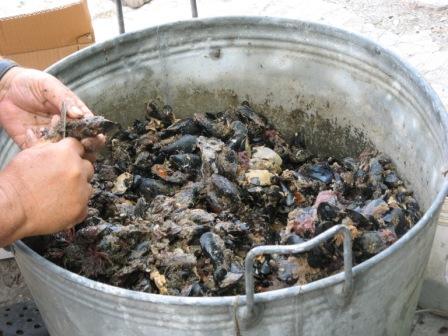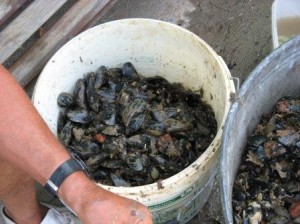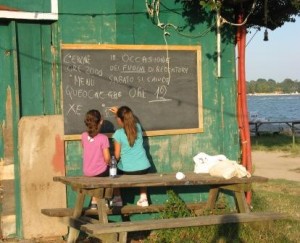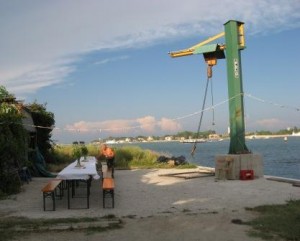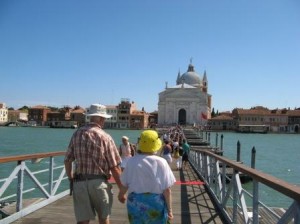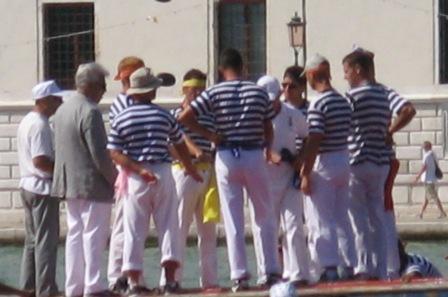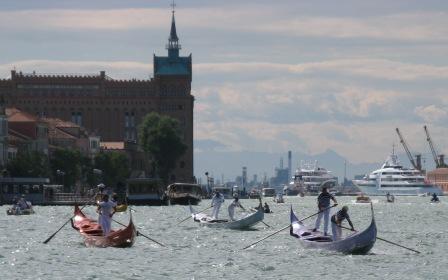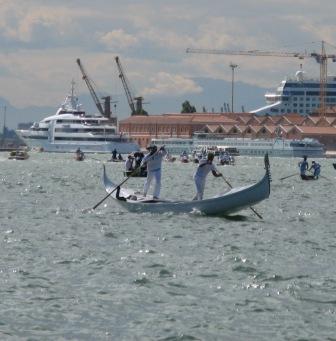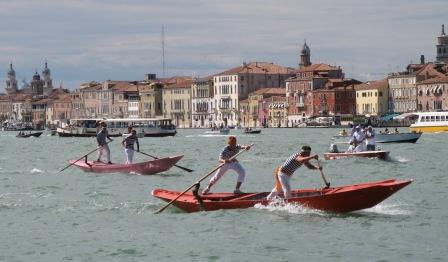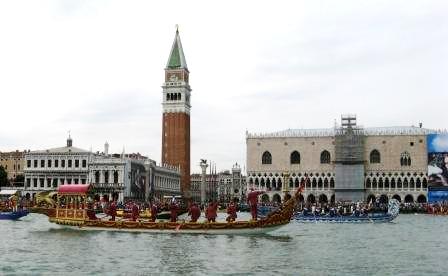
Day before yesterday (Sunday, September 5, for the record) was the day of what is arguably the most important — certainly most spectacular — race of the Venetian rowing season: the Regata Storica, or “historic regatta.” Or, as I also think of it, the Race that Launched a Thousand Postcards — which depict, not the race(s) themselves, but the decorated boats loaded with rowers in costume. If you skrinch your eyes and don’t think, you could imagine you were seeing something from centuries ago. Sort of.
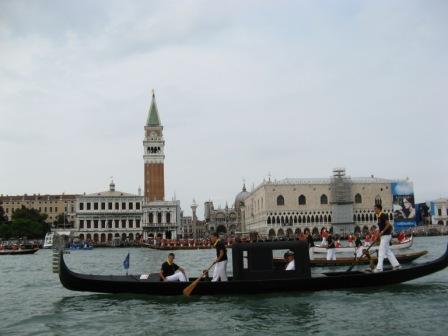
We were there, as usual: Lino in a boat (one of the red launches used by the judges, though which one depended on which race he drew), and me also in a boat (this year in the six-oar balotina, “Katia,” of the Remiera Casteo). Lino’s role was to administer justice; my role was to participate in the corteo, or boat procession, preceding the races, then to tie up somewhere convenient in a spot where we could get a good view of the races, then to scream our lungs out, if and when the spirit moved us. (It did.)

Every year, obviously, is different, though there are equally obvious similarities. Boats of all types and persuasions, from tiny one-person s’ciopons to honking big motorized barges carrying entire clans and enough food and drink to support them till Christmas.
And of course there were the spectators — official estimates said 90,000 — massed together at certain key points: sitting on the steps in front of the church of the Salute, in temporary bleachers just beyond San Toma’, and in rows of chairs at the Rialto market. Maybe somewhere else further on that I didn’t discover. I’m not very clear on how 90,000 people fit into those very limited spaces, but I imagine the estimate includes all of us in the boats lining the Grand Canal, and the relatively few, those happy few, partying on the balconies of the palaces. In any case, there we all were. however many thousand we might have been.

I suppose it’s exciting to watch from the shore, wherever you find a space, but if you were ever to be in Venice on the first Sunday in September, I’d strongly urge you to smash the old piggybank and hire a gondola for two or three hours and watch it from the water. Don’t suppose you can just imagine how it would be. It’s not just the fact that you’re floating, it’s the fact that being in a boat makes you a participant in a way you can’t be if you’re merely pasted along the sidelines, waving.
Two things distinguished this year’s edition. One was the unexpected anarchy (I think it was unexpected, though murmurings a few days earlier may have been a sort of warning) that overwhelmed the corteo near the Rialto Bridge.
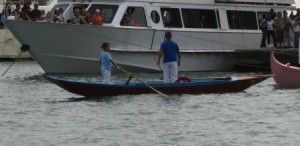
The Master Plan, as devised by tradition and the Comune (not always the same thing), was for the corteo to splash along all the way up to the train station, then return to the vicinity of the finish line at the “volta de Canal,” or “bend of the canal,” by Ca’ Foscari.
The first few years I engaged in the corteo, that’s what we did. Then the Comune, responding to the pressing programming needs of the RAI television wallahs, and who knows what other dark urges, decreed that we all stop on the return leg at the entrance to the Cannaregio canal to let the first one and a half races pass by. It was like shuffling a deck of cards, to get the corteo and the races organized in such a way as to leave not a second of the dreaded dead-air time in which people could, God forbid, get bored or something.

So we did this for a few years, then increasing numbers of boats began to turn around and head back downstream before they got to the station. Then they began turning around even earlier, and so on, till we reached last Sunday, when suddenly it seemed as if some animal instinct urged the migrating boats to virtually all begin turning around just after the Rialto Bridge (which is where the last serious group of spectators are clustered, after which it’s just scattered random boats and who really cares who’s hanging around in front of the train station?). Or turning, as in our case, before the bridge, because the mass of confused retreating boats made forging ahead difficult, as well as pointless. The general atmosphere amid the boats could be summed up in the rude Venetian phrase, “Si ciava” (see CHA-vah, or “screw this/them/it”).
So that was entertaining. I’ve spent years here listening to rants from certain elements among the organizers about how it’s the Venetians’ festival and we should do it the way we want to, not how They tell us to, but this was the first time I’ve ever seen what “Take Back the Night” would look like in real life. It was kind of cool, actually. For anybody, of whatever race or clime, who is annoyed by being treated as a spear-carrier in somebody else’s drama, it was highly invigorating.
This dude had one of the best seats in the house, all by himself and his two oars. All that seems to be missing is a case of beer.
Not sure what the Comune has to say about it, though, because the Gazzettino was awash yesterday in the floods of rancor and glee from the four men contending for first place in the race of the gondolinos. Which brings me to the second thing that distinguished this year’s edition.
These “four men” would be cousins Igor and Rudi Vignotto, on the yellow (canarin) gondolino, and Ivo Redolfi-Tezzat and Giampaolo d’Este on the blue (celeste). To give you some perspective on this rivalry, the “Vignottini” have been rowing against d’Este and Tezzat since 2002, and against d’Este with other partners since 1995. And that’s just the big races; they all started this as kids. Speaking of being able to imagine things, I myself can’t imagine what fifteen years of battling in seven races each year adds up to when the crunch is on in the Grand Canal. But it could not, as the saying goes, be pretty.
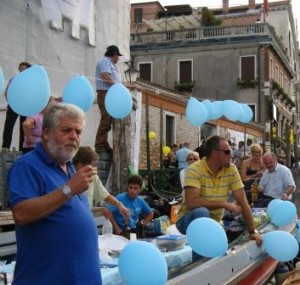
So what happened was that the eternal triad (including the purple, or viola, gondolino of Andrea Bertoldini and Martino Vianello), entered the Grand Canal in a virtual dead heat, and remained so until the Rialto Bridge: celeste, canarin, and viola. And it’s not merely that they accomplished this feat, it’s that they did it for two miles (3.2 km). At top speed, or about 7 mph (12 km/h).
“When I saw those three entering the Grand Canal side by side like that,” Lino told me later, “I got a lump in my throat. It gave me goose bumps.” He and the judges in the other boats following the race literally could not hear each other through their walkie-talkies, even yelling, because however many thousands there were who could see the boats were all screaming their brains out. It was thrilling.
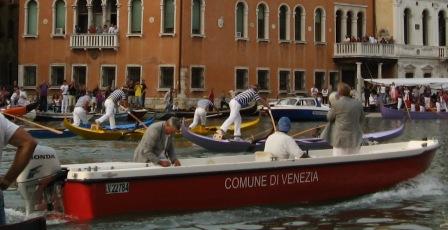
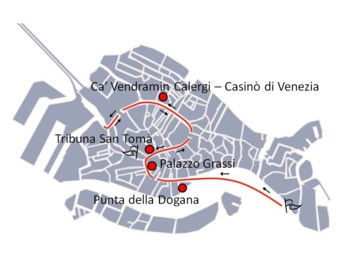
Then, as usual, Something Happened. Last year it was Tezzat falling overboard and taking d’Este with him as their boat (celeste, as it happens — coincidence???) capsized. This year it was Something up toward the temporary piling in front of the station which marks the turnaround point.
The details are still coming out, and of course they’re as dissonant as a quartet by Charles Ives. The judges warned Tezzat more than once to alter something he was doing to the detriment of the “Vignottini,” which Tezzat evidently ignored. (I’m not taking sides here, I’m just trying to give the outline.)
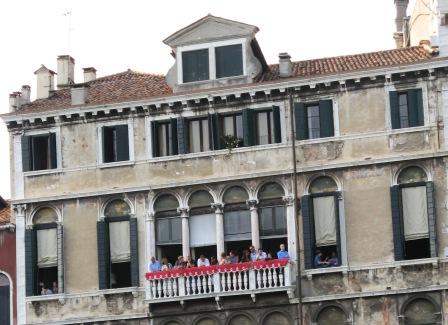
When a racer does not obey the judge, after a certain number of calls the racer is disqualified. And that’s what happened. Three-quarters of the way through the race, suddenly one of its biggest stars was off the field, never to be seen again. At least not that day.
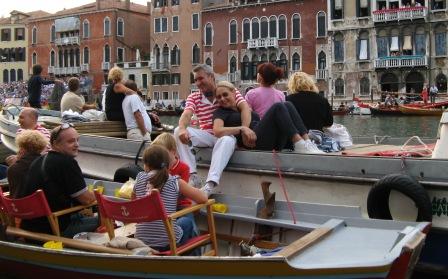
One of the boys from the children's race consoles himself for losing at the last minute by eating several pieces of cake. It helps, at least for a while.
The next day the Rage of Tezzat reverberated through the pages of the Gazzettino; if this matter isn’t resolved (the “matter” being the injustice and infamy of the judge’s action), he says he’s going to hang up his oar, as they say, and quit racing. He won’t even show up to try for the final race of the year at Burano in two weeks.
To which one might reasonably reply, “Knock yourself out.” (“Fa di manco,” would be the closest Venetian equivalent, or “So don’t bother.”)
If there are any developments worth wasting electrons to report, I will do so.
Otherwise, I want to leave you with the joy of the bellowing, shrieking, hysterical crowds who got to see, if only briefly, one of the most dazzling moments in big-time racing anyone has witnessed for quite some time. That’s what I’m going to remember.

